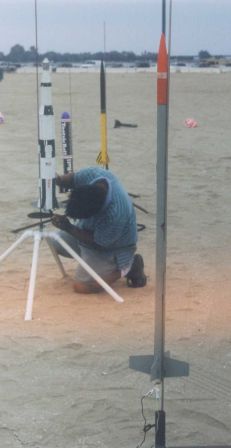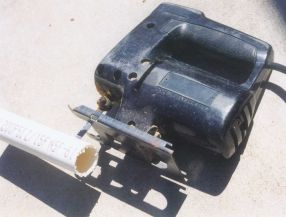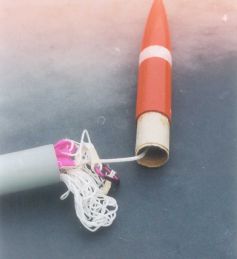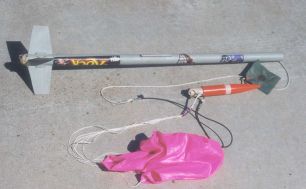Scratch PipeCleaner Original Design / Scratch Built
Scratch - PipeCleaner {Scratch}
Contributed by Larry Brand
| Manufacturer: | Scratch |

Brief:
PipeCleaner is the conventional 4FNC version of my scratch built tube-fin
rocket,
F.I.S.H.. PipeCleaner
is also constructed from 30mm ID PVC plumbing conduit, which I chose for its
waterproof properties since it is possible for water landings at our beautiful
island launch site. The only differences between it and F.I.S.H. are: it is
made in one piece of PVC instead of two, it has 4 trapezoidal fins cut from
3/32" aircraft ply instead of PVC tube fins, and it has a permanent 24mm
motor mount, because 29mm motors (although a perfect fit) are too powerful for
the site and would guarantee a "splashdown". PipeCleaner was laid out
as an exact 53% downscale of the Maximum Thrust Rocketry "Star Quest"
to assure good balance and flying features.
Construction:
The body tube consists of PVC plumbing conduit obtained from Home Depot.
Careful selection can yield a straight enough section to cut a single piece
body tube but there is usually some curvature found in the stock 10' lengths,
so the rocket can be made from 2 shorter lengths if need be. PipeCleaner's body
tube is a 37" section of PVC tube. 3/32" ply trapezoidal fins are
installed through-the-wall by cutting 4 equidistant 3/32" slits in the aft
tube wall with an electric sabre saw. Resist the urge to cut 2 slits at once
just because the blade is long enough to do this--you will screw them up. Cut
one at a time with the blade inserted halfway, and watch your fingers!
I decided to install a 24mm mount permanently, so I epoxied a LOC 29-24mm adapter and then epoxied the fins through the slits on top of it. 2" long triangular balsa pieces were used on each fin base as reinforcement. PipeCleaner can be built for 29mm power (as the PVC tubing is a perfect fit with tape friction fit), but it is critical to install an infrared barrier to protect the aft end plastic from radiant heat of the motor. This is easily accomplished by slitting a 12" section of Estes BT-55 tubing lengthwise, removing a 1/8" wide strip, and then slathering the outside with epoxy before inserting into the aft end. If you don't install an infrared barrier like this, your rocket's rear end will droop like a wet noodle after the first flight.
 The rocket
is now basically done. I recommend using the nifty PML 29mm conical urethane
nose cone for PipeCleaner. This little guy costs $13.95 but the rest of the
airframe only costs $2.00, so you can't complain that much about the expense.
As an alternative, you can use an Estes nose cone, which is a whisker too fat
for the PVC, and construct an adapter for the PVC tubing as follows: cut four
5" and three 2 1/2" pieces of BT-55 tubing, slit the shorter pieces
lengthwise and remove a 1/8" strip from one, a 3/16" strip from
another, and a 1/4" strip from the third, nest these 3 pieces in turn with
glue into the lower end of a 5" piece to reduce its internal diameter,
repeat this slitting and nesting process with the three remaining 5"
pieces, inserting them in turn 2 1/2" into the aft of the piece you just
created. You now have an adapter that fits an Estes nose cone to 30mm ID PVC
conduit. It is not that hard to build but lets you use the Estes cones, which
are cheaper and easier to come by. I use an 18" LOC chute attached to 8'
of parachute cord, anchored to the body tube 2" below the top with a
external knot through a hole drilled in the PVC and then covered with a fairing
made from half a BIC pen cap. Add a small LOC Nomex®
protector if you like. Launch lug is 1/4" fiber, centered 16" from
the aft end.
The rocket
is now basically done. I recommend using the nifty PML 29mm conical urethane
nose cone for PipeCleaner. This little guy costs $13.95 but the rest of the
airframe only costs $2.00, so you can't complain that much about the expense.
As an alternative, you can use an Estes nose cone, which is a whisker too fat
for the PVC, and construct an adapter for the PVC tubing as follows: cut four
5" and three 2 1/2" pieces of BT-55 tubing, slit the shorter pieces
lengthwise and remove a 1/8" strip from one, a 3/16" strip from
another, and a 1/4" strip from the third, nest these 3 pieces in turn with
glue into the lower end of a 5" piece to reduce its internal diameter,
repeat this slitting and nesting process with the three remaining 5"
pieces, inserting them in turn 2 1/2" into the aft of the piece you just
created. You now have an adapter that fits an Estes nose cone to 30mm ID PVC
conduit. It is not that hard to build but lets you use the Estes cones, which
are cheaper and easier to come by. I use an 18" LOC chute attached to 8'
of parachute cord, anchored to the body tube 2" below the top with a
external knot through a hole drilled in the PVC and then covered with a fairing
made from half a BIC pen cap. Add a small LOC Nomex®
protector if you like. Launch lug is 1/4" fiber, centered 16" from
the aft end.

Finishing:
Custom finishing job was with Testors red and flat light aircraft gray,
complete with WWE wrestling stickers to give it some class.
Flight:
Flights over the last 2 years were exclusively on 24mm E30-7 and F21-8 motors
and were nearly out of sight (at least, my sight) on both--it's a skinny rocket
and hard to see. Sims say 1100' and 1700', respectively, on these motors. The main concern,
besides finding it after a 7000' apogee ejection, with using 29mm motors on
PipeCleaner is attaching the fins strongly enough to withstand Mach
effects--you will never shred the PVC airframe--I would use 3/32" or
1/8" G10 glass fins on a 29mm version when used with H-motors, 500 m.p.h.
will be exceeded (an I200 will break Mach), and this would certainly flutter off 3/32" ply
fins.

Recovery:
The LOC chute is more than adequate to bring this rocket down safely.
Summary:
PROs: Cheap and really easy to build, especially with the PML nose cone option.
Excellent 24mm performance despite the weight. Capable of extreme altitude and
Mach performance with 29mm motors. Waterproof for those who fly near liquid
environments.
CONs: Not much. Need to better assure fin attachment if 29mm motors are used. NOTE: Although NAR Safety Code legal, PVC conduit is heavy and extremely tough stuff. I wouldn't want one of these rockets to hit me, especially after an ejection failure. Use caution, even though PipeCleaner is "only" a 24mm rocket weighing well under one pound.
 |
 |